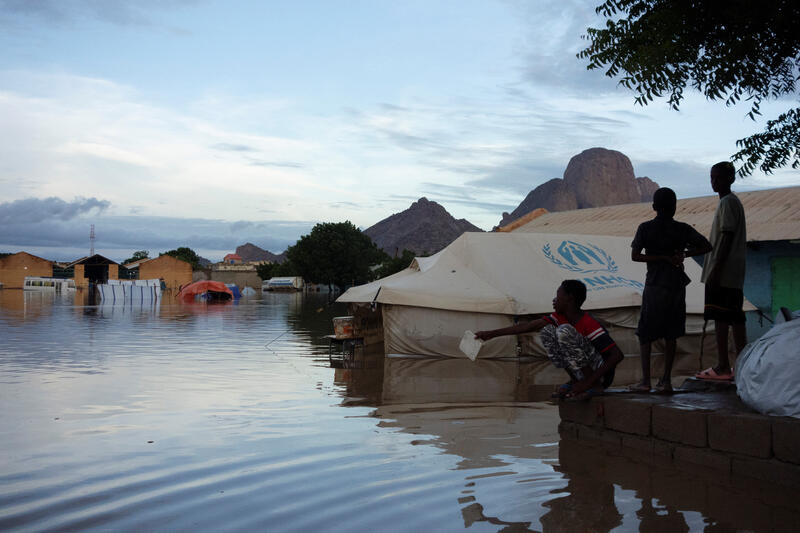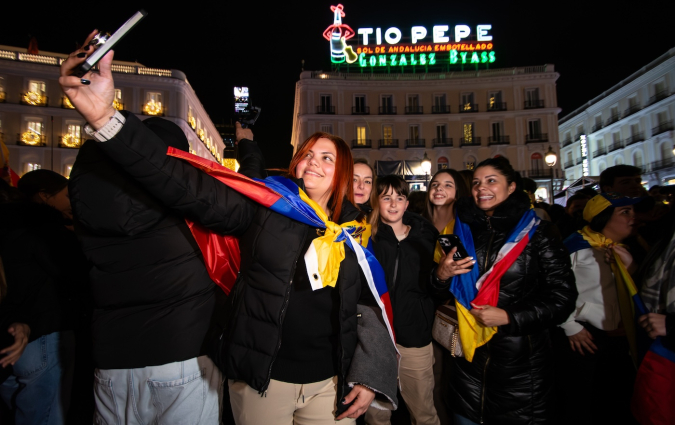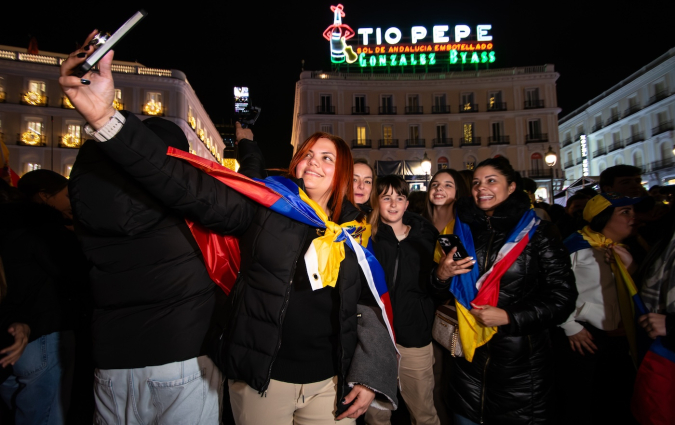"Climate change is a really good laboratory for tackling so many of the problems we have in journalism"

Displaced Sudanese children stand near a flooded UNHCR tent through a flooded street, July 26, 2024. REUTERS/Mohamed Abdulmajid
This is a lightly edited text of the keynote speech by Katherine Dunn, Content Editor, Oxford Climate Journalism Network, at the Conference on Climate Journalism in Eastern Europe and the Caucasus, Tbilisi, Georgia, 28 August 2024
Our work is all about helping journalists improve their climate literacy, and also connect climate to all the other roles and beats in the newsroom. And that includes conflict.
But less than two months into the start of the Oxford Climate Journalism Network at the beginning of 2022, this new, shiny experiment faced a stark challenge. Because, of course, Russia invaded Ukraine.
The questions about better climate coverage we were gathered to ask suddenly seemed like they might be overtaken by other questions.
Those included: how do we talk about this moment? How do we be in a room together? Can we cover climate change this week, or next week? Why do this right now?
The Intergovernmental Panel on Climate Change was also grappling with this. This is the UN body that brings together climate scientists around the world, often across huge geopolitical divides. And just days after the invasion, their latest report was due to come out.
Now as many of you will know, these reports take years to be put together. But they’re difficult to cover at the best of times—they kind of embody what can make climate coverage challenging in the first place. They’re usually terrifying. They’re huge. And they’re often very technical.
And this particular report was now going to compete for newsroom attention with a war, while the Ukrainian scientists were literally heading for the bomb shelters.
My colleague Diego and I wondered how journalists in the wider region would manage to cover the report, or if they would at all. So we asked them.
One of our members, Patryk Strzałkowski, a reporter at Gazeta in Poland, told us that he wrote an article on the report during a night shift while doing live coverage on the war.
This turned out to be pretty typical. Several other journalists in the region covered the report in between war coverage, and trying to reach or help friends or colleagues get out of Ukraine.
Others were immediately taken off the climate desk and put onto covering the war full time, sometimes permanently. Others told us later they had covered the IPCC report, only to watch their story go unpublished.
Since the invasion, this question—of how conflict and climate intersect—has only gotten bigger, and more complicated, and put more demands on our members around the world.
Demands on their time and energy, of course. But also on their sense of urgency and their sense of hope.
Of course, on October 7, Hamas’ attack on Israel killed more than 1,200 people. And Israel’s bombing of Gaza has now killed at least 40,000 people, and threatened to destabilize much of the wider Middle East.
We are seeing rising conflict and geopolitical tension around the world. From Sudan to the Sahel to Taiwan. Many of our members are living with a constant level of conflict and political uncertainty. Often the crises in their regions are little-covered in international media.
And I know the question that often gets asked of them, when they try to cover climate change amid so much instability and so much uncertainty.
They get asked: there’s so much to worry about already. Why cover climate change, too?
‘The historical links between climate and conflict.’
If you’re a keen reader of history, you’ll know how deeply the connections between conflict and climate go.
The struggles over natural resources. The fall-out of climatic disasters. The race by European powers to extract the natural bounty of much of the rest of the world.
But I want to take you back to a moment that has recently captured my imagination.
In the early 1950s, a group of American scientists suggested that they should try and revive a famous scientific collaboration: the International Polar Year.
The first International Polar Year was held in the 1880s, and one of the key ideas was that it wasn’t possible to study the polar regions without international collaboration. Twelve countries participated.
The second International Polar Year took place in the early 1930s, and attempted to study both the Arctic and the Antarctic in greater detail. The teams set up 40 permanent observation stations in the Arctic alone. This time the project brought together 40 nations.
Not surprisingly, World War II put a stop to international scientific collaboration for many years.
The idea to revive the Polar Year came during the Cold War. It was renamed the International Geophysical Year, and the idea was that the collaboration would stretch across the Iron Curtain, and 67 countries participated.
The focus now wasn’t on just the poles, but earth itself, including its shape and gravitational field. The ocean tides, the ice sheets, the mysteries of the atmosphere.
Of course, such a collaboration was never as simple as the search for knowledge.
Obviously not. It was the Cold War, and the IGY quickly evolved into a largely two-sided race: the race to build the world’s first satellite.
This competition led to the launch of Sputnik in 1957, then the launch of the first American satellite. It was essentially the beginning of the Space Race.
And with it, it became a landmark moment in the acceleration of the nuclear arms race.
There were many remarkable characters involved in this project, and frequently their motives both overlapped and contradicted one another. To better understand space. To better destroy their enemies. And to better understand earth itself.
Because the IGY also marked the start of a new era of climate science. The IGY was responsible for the world setting aside the Antarctic for scientific study. It directly led to a lot of the satellites that measured the ice sheets, sea level rise, and levels of CO2. All of this owes a debt to the IGY. (And the next polar year, which was in 2007-2008, focused explicitly on climate change.)
The discoveries of the IGY showed the globe for the first time from a distance—a bird’s eye view—and revealed that the planet is not only not perfectly round, but a complex, and dimpled and ever-changing sphere. A truly remarkable place.
The push to understand our world, and to destroy it, were in that one international project, deeply intertwined.
Two sides of the same coin, reinforcing and emboldening one another.
‘Inter-linked climate and conflict’
Today, we see those same interrelationships on the ground, and we see them all over the world.
One of our OCJN alumni, Murtala Abdullahi, is a journalist and analyst from Nigeria who covers the vast Lake Chad region of west and central Africa.
Climate and conflict are not a one-to-one relationship, but more like a “prism” or a “web”, that touches everything, Murtala says.
As the Sahara encroaches on what was once family farmland, it results in a loss of livelihood, community, and stability.
It also produces a crisis of food and water insecurity, and often creates conflict between communities fighting over increasingly scarce resources. And it often creates a gendered crisis, as members of families—often men—move to growing cities looking for work.
This in turn is contributing to vast migration. Due to a combination of conflict and climate change, the UN says that a record-breaking 110 million people were displaced globally by the end of 2023.
Our members all over the world can see it with their own eyes, whether they’re in Turkey or Namibia.
Often the causes are so intertwined that it’s hard to say where one begins and another stops.
‘The links between climate and conflict especially disinformation’
Climate disinformation is also now being used as a weapon.
In July, NATO said that the Russian government and Russian state media has routinely spread climate denial and disinformation, and that there has been a notable uptick in this spread since the invasion of Ukraine.
The disinformation often frames global warming as a “hoax” and a form of “Western imperialism” designed to keep poorer nations from economically developing—when in reality we know that poorer nations are simply more vulnerable.
And Russian disinformation has been linked to campaigns to undermine and attack climate activists— and to use gendered harassment against female activists in particular.
But members tell us that disinformation, often sown by governments, impacts their work and puts them at risk around the world. That’s whether they are covering air pollution in India or deforestation in Brazil.
The year after Russia invaded Ukraine, one of our alumni, a Kyrgyz journalist called Baktygul Chynybaeva, wrote an essay for us on the importance of documenting the reinforcing loops between climate and conflict, looking overtly at Russia.
“But although it’s challenging for journalists to truly connect the dots between conflict and climate change, it is crucial to do so,” she wrote, after detailing her own challenges covering these links.
“Though the war has woken the world up to its energy dependence on Russia, and the implications for both the climate and geopolitics, Kyrgyzstan is a telling example.”
Barriers to covering climate change
We can see that climate both feeds conflict and is impacted by it. It is interconnected.
But do we cover it that way? Often, the answer is no.
The striking thing about working with nearly 600 journalists over more than two years is that there is no country on earth in which a journalist isn’t being told: “we have bigger problems than climate change right now”.
In fact, from countries who are being wracked by conflict and war, to those that are, by every metric, peaceful and prosperous, there is always something more pressing than the future of the natural world.
What is often striking about climate journalism is not how different we all are, but how similar.
It’s useful that we have so much in common across the world, because when it comes to the region we are in now, we have a remarkable lack of information.
The Reuters Institute’s own Digital News Report, which studies 47 countries does not include Georgia. Nor do most other major studies about climate communication and journalism.
So you’ll forgive me for speaking broadly about many of the challenges journalists face both in general, and when covering climate and conflict.
Of course, around the world, journalists are struggling with a lack of resources, widespread harassment, and political pressure. This cuts across most topics.
On climate, this is both general political pressure and interference. But also the weaponised, incorrect claim that covering climate change is inherently biased or a form of activism.
There are also the regular claims that climate coverage is technical, boring, and depressing—and that audiences simply don’t want to consume it.
This is something we hear anecdotally again and again. People just don’t want it.
But here is the counter argument.
There is compelling evidence from around the world that audiences do actually care, and deeply, about climate change.
In a study released this February, nearly 60,000 people across 63 countries were surveyed on whether they “believed” in climate change. Eighty-six percent of respondents said yes.
And by “believed” the surveyors clarified: 1) whether humans were causing climate change, 2) whether it was a serious threat to humanity, and 3) whether action was necessary.
The country with the lowest level of belief of those 63 countries, Israel, was still 73%.
Ukraine was also polled on the level of belief in climate change and whether action was necessary. The figure was 88%.
You may have wondered, as I did, when this data was collected. It was collected between July 2022 and July 2023.
And you may wonder, as I did, if this was a one-off conclusion.
But in fact, multiple studies have found that the level of concern for climate change, and desire for action, is actually extremely high across the world.
The other astonishing fact is that we tend to doubt how much others feel the way we do.
In fact, around the world people seem to systematically underestimate how much their fellow citizens care.
‘If people care, then what . . .’
We know that there is often a very big gap, on all kinds of different issues, between what people say they want, and care about, and what they actually do.
But for us as journalists, this information shows us that we’re often dealing with the wrong question.
That question isn’t how we get audiences to care about climate change.
The question is: how do we better cover climate change, knowing that people already do
Looking at the reasons behind the high rates of news avoidance, the Institute’s Digital News Report notes that news organisations can draw different conclusions, depending on their own mission and target audience, but . . .
“Taken as a whole, it is clear news consumers would prefer to dial down the constant updating of news, while dialling up context and wider perspectives that help people better understand the world around them.”
“Most people don’t want the news to be made more entertaining, but they do want more stories that provide more personal utility, help them connect with others, and give people a sense of hope.”
There is never going to be a one size fits all prescription for climate coverage. There’s no one size fits all prescription for any coverage, or any conflict, or any approach to climate action.
But there’s a clear demand for a kind of journalism that goes back to many of the core ideas of our profession, and of storytelling.
Audiences are telling journalists that they want context. They want to follow the news in a way that gives them agency. They want stories with real human beings in them. And they want us to connect the dots.
It really requires us to do the kind of journalism that can’t be done on autopilot, or to formula. We have to think about why we’re telling a story, and how.
The other piece of good news is that climate change is a really good laboratory for tackling so many of the problems we have in journalism.
Get this right, and it can help us across all kinds of beats. Get this wrong, and we relegate the biggest story of our time to a sidebar.
In this sense, climate and conflict struggle with many of the same challenges.
There are so many of the same emotional questions of despair and hope, the balance between technical details and human loss and survival. These stories require us to remain in touch with what really makes life worth living, what it is in the future we want to see.
Here, as with conflict, false positivity, or the search for simplistic or easy solutions, often aren’t helpful either.
I often go back to an essay an OCJN alumna called Lameez Omarjee, who covers climate change at News24 in South Africa, wrote for us.
Her essay was on the importance of these kinds of human stories—in this case, how to connect climate change with human stories and what we value.
She chose to focus on heritage, and in particular national parks— and how they were being impacted by climate change. And she chose a very personal reason.
“As a person of colour growing up in South Africa, I and many others had parts of our heritage taken away by the apartheid regime,” wrote Lameez.
“There are now parts of my family tree, my heritage, that are missing. I carry that loss now, and I wouldn’t want others and future generations to experience the same thing, especially if it can be avoided with meaningful action to limit climate impacts.”
It is this interdependence between the natural world and human conflict that is so fundamental to why we can’t cover one of these topics without the other, and why neglecting climate is not an option we have.
I want to finish with one of my favourite quotes.
In 1961, Walter Sullivan, a science journalist at the New York Times journalist wrote a book about its history looking back on the International Geophysical Year, with the space race already well underway.
And he finished by noting that, “in studying itself, the world has grown closer together.”
“We have come to learn that hurricanes, drought, and pestilence know no national frontiers,” he wrote.
“And we have come a little closer to a cosmic view of our planet—a water-crusted sphere, crusted here and there with continents upon which there is the fragile green hue of life.”
In every email we send you'll find original reporting, evidence-based insights, online seminars and readings curated from 100s of sources - all in 5 minutes.
- Twice a week
- More than 20,000 people receive it
- Unsubscribe any time







